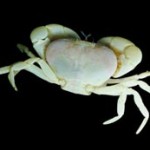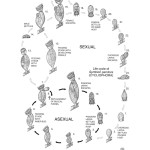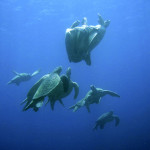Post by Jon Copley. Dr. Jon Copley is a lecturer in marine ecology at the National Oceanography Centre in Southampton, UK. He is also director of SciConnect Limited, a company providing training in science communication and media skills. Jon is an avid deep sea explorer and studies the reproductive ecology of deep sea invertebrates, especially those from methane seeps and hydrothermal vents.

At one point in the spectacular IMAX documentary “Aliens of the Deep”, director James Cameron says of life at hydrothermal vents: “That party’s been going on down there in the dark for the past billion years… the Sun could go out tomorrow, and they wouldn’t know, and they wouldn’t care.”
He is referring, of course, to the fact that food chains at hydrothermal vents are ultimately based on chemosynthesis – the production of organic matter by microbes using chemical energy – rather than photosynthesis by plants.
This chemical dependence would seem to grant life at vents independence from the sunlit world above, at least on ecological timescales (although on longer timescales, most vent animals still require oxygen that comes from photosynthesis in surface waters).
But if life at vents is divorced from the sunlit world above, why do some vent species follow seasonal cycles in their sex lives? Shouldn’t the passage of our tilted planet around its star be completely irrelevant to life in these chemically-powered islands on the ocean floor?
Figuring out why some species reproduce seasonally at hydrothermal vents, and in other chemosynthetic environments such as cold seeps, may tell us what lies behind deep-sea reproductive patterns in general.
Biologists have known for a couple of decades that some “normal” deep-sea species reproduce seasonally. But away from vents and seeps, there are two possible explanations that are seemingly inseparable.
The first is food availability. Food is usually scarce in the deep sea. But if an animal lives beneath an area where there are seasonal blooms of plankton in surface waters, it may receive a seasonal peak in organic matter sinking to the seafloor. This seasonal manna from above could fuel seasonal reproduction.
But there is another possibility. Rather than being an ecological – or “proximal” – response to variation in energy available to adult animals, seasonal reproduction in the deep ocean may have an evolutionary – or “ultimate” – cause.

It may be that some deep-sea species have evolved – or retained – seasonal reproductive patterns to provide their offspring with the best possible food supply for them to grow up. If a species produces larvae that feed in the plankton, natural selection may favour those that time reproduction to release their larvae when there is most food sinking from above.
In the “normal”, non-chemosynthetic deep sea, it is very hard to separate these two possibilities. But at vents and seeps, there is plenty of food available to adult animals all year around, thanks to the bounty of chemosynthesis. So if seasonal reproduction in the deep sea is driven solely by an ecological or “proximate” cause, then there should be no seasonal reproduction at vents and seeps. And if seasonal reproduction has a solely evolutionary or “ultimate” cause, it should only occur in deep-sea species that have feeding larvae.
Ten years ago Paul Tyler and Craig Young published a review of reproduction at hydrothermal vents and cold seeps, pulling together information available from around 20 species at that time. Today we know something about the reproductive patterns of at least 62 species from deep-sea chemosynthetic environments. Among those 62 species, researchers have now proposed seven that may reproduce seasonally.
I’d like to be able to say that all of those seven species have feeding larvae, but they don’t. However – and I admit this may sound like special pleading – you have to be very, very careful when interpreting “evidence” for seasonal reproduction in dynamic environments such as hydrothermal vents.
Deep-sea vents are very changeable places to live. Changes in the physical environment at a vent – which occur frequently – can result in changes in the reproductive development of populations living around that vent. So although something may look like a seasonal pattern of reproductive development in samples from only one year, it could just be a coincidence. You really need to check samples from several years – and see a consistent seasonal pattern in them – to be sure.
Applying these kinds of stricter criteria to the evidence, I think we can only be really confident of seasonal reproduction in four species from vents and seeps so far. And all of them have larval stages that feed in the plankton.
Of course, it is impossible to prove a negative – in this case, that there are no seasonally-reproducing species at vents and seeps that don’t have feeding larvae. But the fact that there is seasonal reproduction at all in chemosynthetic environments supports the idea that seasonal sex lives in the deep ocean may have an “ultimate”, evolutionary cause.
Finding seasonal reproduction at vents and seeps also raises a further puzzle: how do animals living there have any inkling what season it is? What kinds of environmental signals are available for them to “tell the time” to get it on?
Elsewhere in the deep sea, seasonal variations in organic matter sinking from the surface offer an “energy signal” – at some times of year, animals will have more energy available to them than others. But chemosynthesis provides plenty of energy to animals at vents and seeps all year round, swamping any “energy signal” in organic matter sinking from the surface.
However, food produced by photosynthesis may contain “biomarker” sterol compounds that are not found in organic matter produced by chemosynthesis. So perhaps seasonally-reproducing animals at vents and seeps can “taste” the peak in surface productivity.
Some researchers have suggested that some species – particularly shrimp – may actually need these photosynthetically-derived sterol compounds for successful reproduction. If so, then seasonal variation in the supply of those sterols from surface waters could drive seasonal reproduction in such species at vents and seeps (and we’d be back to a possible ecological cause for seasonal reproduction!). But I don’t buy it for three reasons. Firstly, similar shrimp appear to provision themselves with a lifetime store of these compounds while feeding in the plankton as larvae.
Secondly, similar shrimp still manage to reproduce at sites beneath oligotrophic gyres – desert-like, nutrient-poor regions of the ocean where there is hardly any photosynthetic production at the surface, let alone arriving at the seabed thousands of meters below. And thirdly, two of the seasonally-reproducing species from vents and seeps have now been kept in aquaria, where they have continued to follow their seasonal patterns without being given any photosynthetically-derived food.
But there may be another possibility. The four vent and seep species where seasonal reproduction is uneqivocal come from sites shallower than 1000 metres. Those sites lie in the dysphotic or “twilight” zone, where there is still very faint downwelling light from the surface. Perhaps some species can sense this light, and use variation in day length as the signal to synchronise their sex lives.
In conclusion, finding seasonal sex lives at hydrothermal vents and cold seeps is something of a puzzle wrapped in an enigma. But it may help us to untangle the knotted explanations for seasonal reproduction in the deep sea. And it suggests that if the Sun did go out tomorrow, some animals down there would still “know” about it. Patterns of life in vent and seep species with larvae that feed in the plankton are perhaps not so independent of the sunlit world above; the spectacular populations of adult animals that we see in chemosynthetic environments are just one snapshot from their life cycles.
Alvinocaridid shrimp near an eruptive vent filmed on the 2009 NW Rota Expedition (off of New Zealand). Video courtesy of Bill Chadwick, OSU and AIVL/WHOI.






Excellent overview Jon! Can you tell me what those four species are (I know one is B. childressi)?
I think it is Alvinocaris stactophila, Bythograea thermydron and Calyptogena kilmeri according to Copley & Young 2006.
Hi Shawn and Kevin – the four I’m “confident” about are Bathymodiolus childressi (Tyler et al., 2007 Mar Biol), B. azoricus (Dixon et al., 2006 JMBA; Colaco et al., 2007 J Exp Mar Biol Ecol; Kadar et al. 2007 J Exp Mar Biol Ecol), Alvinocaris stactophila (Copley & Young 2006 MEPS, ok I’m biased on that one!) and Bathynerita naticoidea (Van Gaest, 2006 Masters thesis).
All those studies are from either shallow GoM seeps or the Menez Gwen vent field, i.e. < 1000 m deep (and Ana Colaco tells me that the B. azoricus population at the nearby 1700 m deep Lucky Strike vent field does not show seasonality).
I’m having another look at Bythograea thermydron; Perovich et al. (2003; MEPS) proposed it as seasonal, from a nice time-series of samples. But I have a few nagging doubts about some methodology (not at all a criticism of Perovich et al., as the bit that’s worrying me was done in our lab!). It may well be seasonal – if so, it would be one species from beyond the dysphotic zone, raising interesting questions about cues.
The other two species I think may need re-evaulation are Calyptogena kilmeri (Lisin et al., 1997; Invert Repro Dev) and Buccinum thermophilum (Martell et al., 2002; J Moll Stud), for various reasons that I hope to go into in a future review paper.